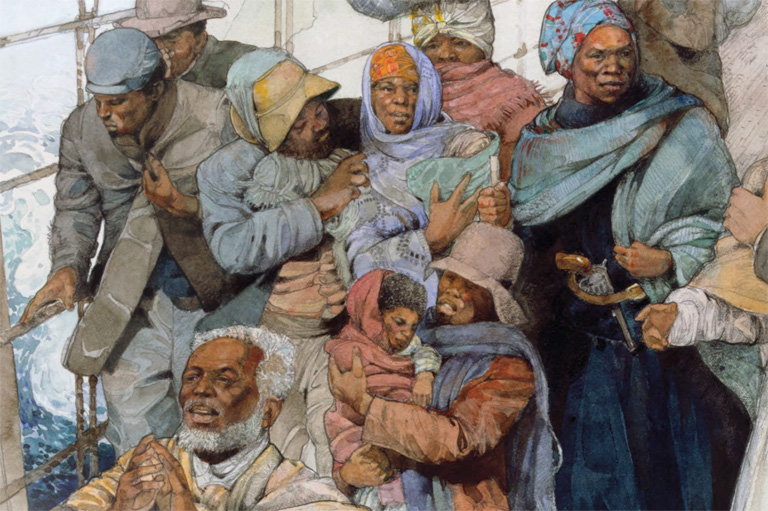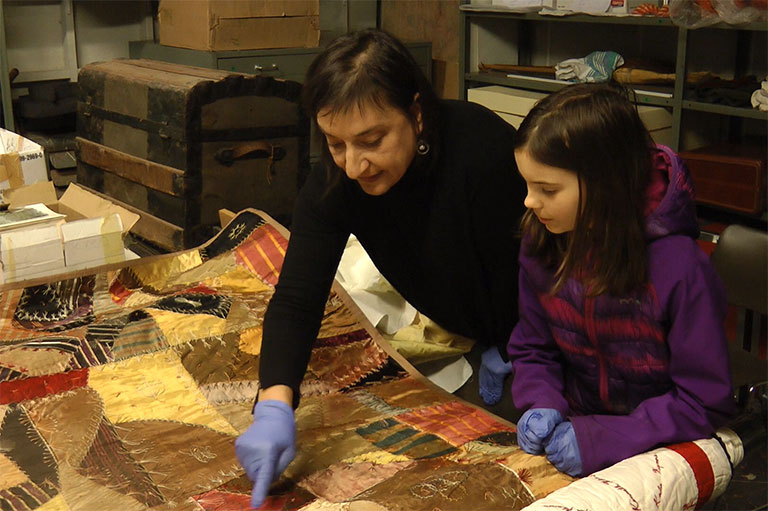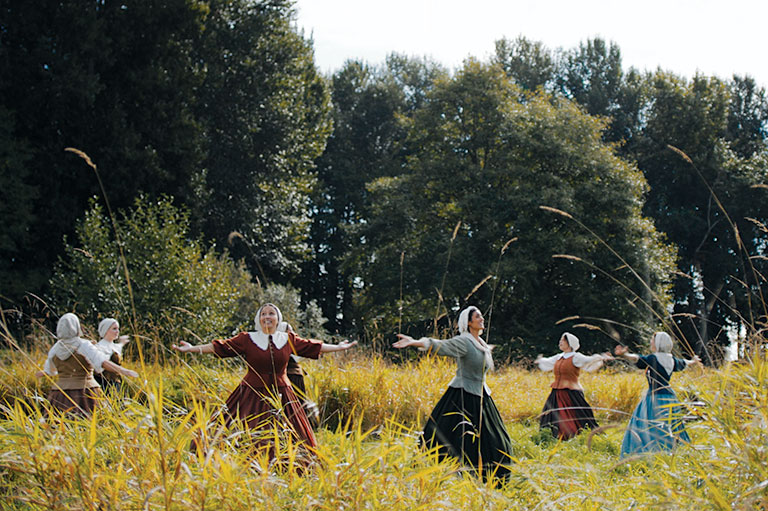Old-School DIY

You’ve dreamed about escaping the bustle of everyday life, imagining a time when you weren’t constantly battling with your kids over screen time, without long days at the office toiling under fluorescent lights, and free of traffic jams and taxes.
You yearn for the simple life, with plenty more time for friends and family. The days would be filled with hearty shared meals, time spent in nature, honest work, and a sense of community. Sounds like paradise, right?
Or would it be?
The truth is, the past is a tougher place than most of us realize — filled with intense manual labour at work and around the home, often-gruelling modes of transportation, illnesses that could easily turn fatal, limited creature comforts, and unreliable communication.
But, if you still insist that life was better in the past, here are some tips and tricks you’ll need to survive in early Canada.

How to make spruce beer
It’s 1535, and you’re part of Jacques Cartier’s exploration crew arriving in what will eventually become Quebec. The weeks-long voyage across the Atlantic has been perilous. Now, to make matters worse, you feel exhausted, weak, and irritable. You bleed easily, and your joints ache. Some members of the crew are losing teeth from their rotting gums.
That’s right — you have scurvy, which we now know to be the result of a vitamin C deficiency.
Thankfully, the Haudenosaunee take pity on you and share their cure: spruce beer, which can be brewed during winter months when fresh produce — also a source of vitamin C — isn’t available. For a non-alcoholic drink, simply boil spruce twigs in water and then strain off the liquid. The alcoholic version has a few more steps.
- Fill a large pot with water and bring to a boil. Add spruce twigs until the water just covers them.
- Roast oats in a pan. Add to pot.
- Toast a few slices of bread. Add to pot.
- Boil until about half of the original amount of water remains and bark loosens from the twigs. Strain.
- Add molasses or brown sugar to the liquid. Put the mixture into a barrel. Add yeast. Remove scum from the liquid.
- Allow mixture to ferment for several days before drinking.

How to cure cod
It’s the 1850s in a Newfoundland outport. Although you’re no pirate, day after day you feel like you’ve struck gold with a scaly fortune of your own: seemingly endless stocks of cod like the catch you’re hauling home.
Thick, yellow-tinged Newfoundland cod is popular worldwide, and the industry employs thousands. Mechanical refrigeration doesn’t exist, so to preserve your fish you must cure your catch using a centuries-old salting method. “Making fish,” the process of drying and salting cod, is a seasonal business that involves the entire family.
Although there are many ways of curing fish, you and your family will be making lightly pickled cod. It is a complex and technical process but yields a high-quality product.
- Find at least two other people to help you to dress the cod. One cuts the throat of the fish and makes a cut down its belly. A second person guts and beheads it. The third splits the fish open to its tail and cuts out the bones.
- In the bottom of a watertight barrel, lay a row of fish with the scaly side down. Sprinkle salt lightly on thin parts and more heavily where the fish is thicker. Layer another row of fish and salt it, repeating the process until the barrel is full. Leave for three to five days.
- In a large tub, rinse away the brine and scrub off any salt that has accumulated on the fish.
- Leave the fish in a pile, called a “waterhorse,” on the fishing stage (a wooden platform at the water’s edge) to drain.
- Carefully spread the fish across flakes (wooden platforms for drying fish). Dry the fish, scales down, until they become stiff, then flip them so their scales face up. If it starts to rain or snow, pile the fish to protect them and then spread them out again. Drying the fish completely takes between two and six weeks.
With 7 uniquely curated newsletters to choose from, we have something for everyone.
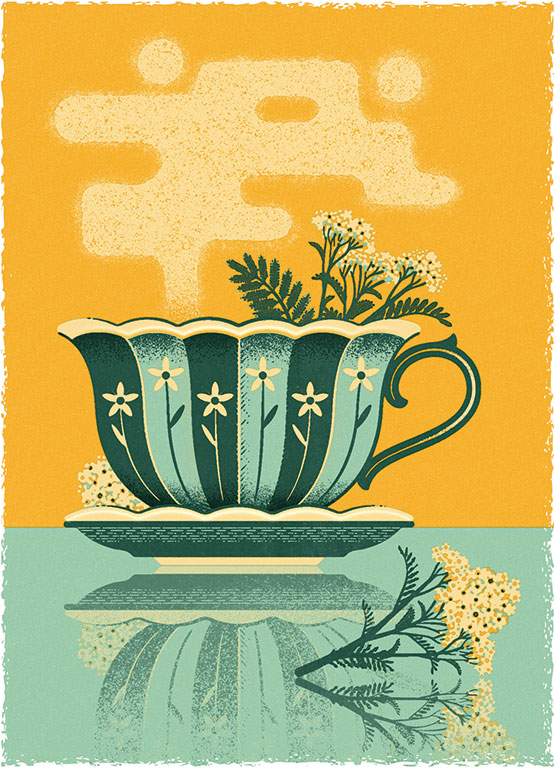
How to treat the flu
You feel feverish, you have the chills, and medication to treat your condition is still centuries away. You shiver in your drafty 1830s log cabin, knowing that your influenza, if left untreated, could be fatal.
So you turn to a Mi’kmaq neighbour, who fights the flu using knowledge passed down through generations. She recommends making a hot drink using yarrow (Achillea millefolium), which is a flowering plant that can also be used to stop blood flow, to treat insect bites, and to relieve toothaches.
When picking the plant, make sure you go with someone who is familiar with the local flora, since yarrow — with its small white flowers — looks very similar to poisonous hemlock. A tea made from yarrow will increase your body temperature to make you sweat, an effective treatment for the early stages of the flu. Pregnant women, however, should avoid ingesting yarrow.
- Harvest yarrow. You can dry some to use another time.
- Add a small handful of leaves or flowers to boiling water. Let steep for fifteen minutes.
- Strain the liquid. Drink up to three cups of the yarrow tea throughout the day.
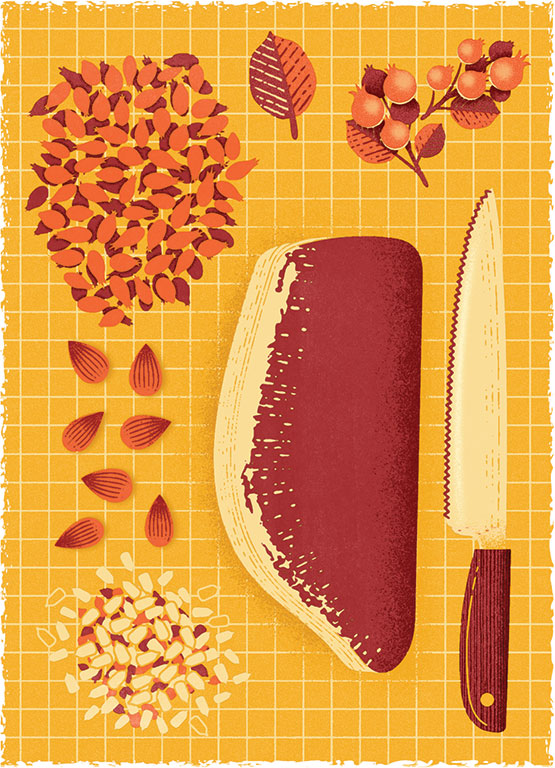
How to make pemmican
It’s the start of the fur-trading season. You and the other voyageurs are preparing for another long journey to the interior of the continent. At a Métis camp near the Red River Colony in what will someday be known as Manitoba, you line up to receive the bundles of pemmican that will keep you fed and fit during the arduous months ahead.
Nutritious and high in protein as well as calories (you’ll burn at least five thousand a day), pemmican is a traditional Métis food usually made of dried bison meat, bison fat, and berries, such as saskatoons, chokecherries, or blueberries.
The women who make the pemmican also sew bags made of bison hide to contain it. When stored properly, pemmican will keep for years without spoiling.
- Cut bison meat into long, thin strips. Dry over an open fire or in the sun.
- Pound dried strips between rocks until flaky. Put the flakes in a bag made of bison hide.
- Pour hot bison fat over the flakes.
- Add dried berries and stir.
- Sew the bags shut and let them cool.
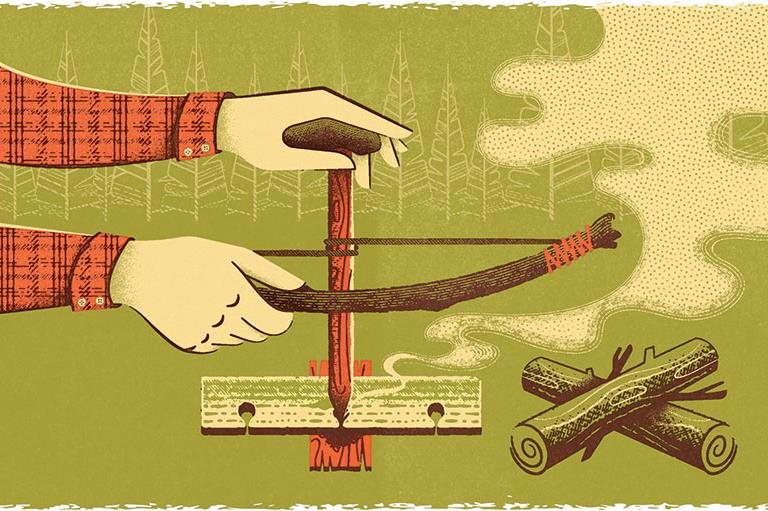
How to start a fire with a bow drill
It’s the eleventh century, and back at Straumfjörðr — the Norse community in northwestern Newfoundland that will someday be known as L’Anse aux Meadows — the villagers are preparing for winter. Your assignment: Head inland and return with meat.
Although there’s not as much big game as back in Scandinavia, you should be able to catch some beaver, red fox, or Arctic hare. On occasion, you might come across the tracks of black bears or wolves. There are vast herds of caribou across the water in Markland, in what will eventually be called Labrador. But the moose that will be so prevalent on this island in the future will not be introduced until the 1870s. As night begins to fall, you prepare to make camp.
Alas! You’ve forgotten your flint back at Straumfjörðr. Looks like you’ll need to start your fire the old-fashioned way. With a sigh, you set to work building a bow drill.
- Find two sticks — one straight and dry, about fifteen centimetres long, and the other slightly curved, roughly sixty centimetres in length. You’ll also need two short, flat pieces of wood — one bone-dry, to be placed on the ground, and the other slightly damp, to be used to apply downward pressure while operating your bow drill. If you can’t find flat pieces of wood, you can always use your axe to split some off a log. Willow, balsam fir, aspen, or spruce are the preferred species.
- Collect dry dead plant matter such as leaves or grasses for a tinder bundle.
- Cut a small notch in your dry, flat board and then remove a small wedge from your notch. It should be no more than one eighth of the circumference of the notch. Place the board on the ground. Make a small notch in the other board as well.
- Tie a length of string to each end of the curved stick, leaving a bit of slack. Loop the string once around the straight stick, or “spindle.”
- Hold the dry board in place with your foot and insert the bottom end of your spindle into the notch. Take the second notched board and place it on top of the spindle as a cap.
- Grasping the curved bow in your dominant hand, make a sawing motion, turning the spindle in the notch while pushing down with your opposite hand.
- Saw the bow drill for an unbearably long time. Keep going. No, seriously — just keep going forever. Eventually, a small pile of hot wood dust should begin to accumulate. This is your “coal.”
- With a knife, transfer the coal to your tinder and blow gently until flames ignite.
- Remember not to forget your flint ever again!
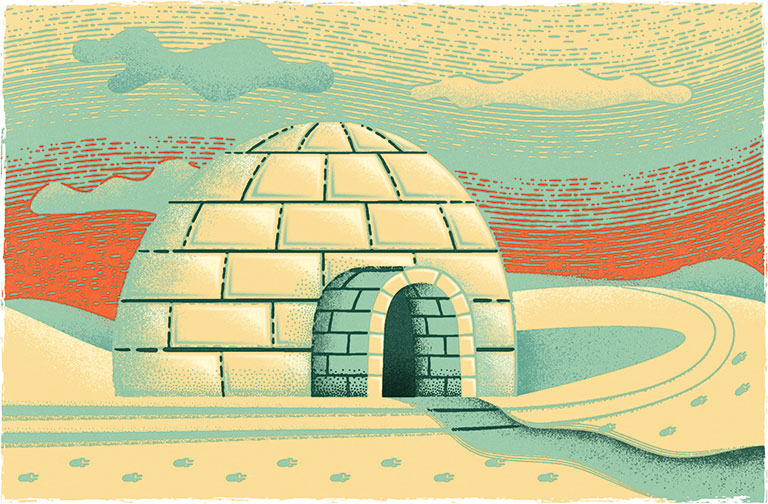
How to make an igloo
It’s 1847, and you’re part of a Hudson’s Bay Company exploration mission to the Melville Peninsula in the Canadian Arctic. Caught by a storm while away from your base camp, you need shelter fast. Fortunately, you’ve learned the art of igloo-making from Inuit you have encountered on your journey. They have built these architectural wonders for millennia.
The igloo’s parabolic shape provides support for the structure and prevents it from collapsing. The building material — snow — acts as an insulator, so any heat generated inside the dome mostly stays there.
The Inuit would dip their savgut, a probe made of a thin piece of bone, wood, or antler, in and out of the snow to determine its depth and quality. The snow should be solid but not too dense. They would then use their pana, a long-bladed snow knife, to cut blocks of snow.
- Draw a circle in the snow marking the perimeter of your igloo. Your building blocks will come from within this circle, making the inside of the igloo deeper than the snow on the outside.
- Cut blocks of snow from within the circle. The blocks can vary in size but usually measure roughly one metre by sixty centimetres by ten centimetres.
- Place the blocks in a ring around the perimeter of your circle. Once the first ring has been laid, shave the edges of the first few blocks so that they form a ramp. Start the second layer from this slope, shaving the blocks as you go. As you continue to build, the blocks will spiral upwards. Bevel the tops of the blocks inwards, so that the structure will dome. The keystone block will be placed directly above you. Shove a block through the narrow opening, trimming its sides until it wedges snugly into the space.
- Since you built the igloo around yourself, use your knife to carve a small entrance. Do this before you suffocate.
- Using loose snow or smaller slices, fill any gaps between the blocks.
- Carve a hole in the side of the igloo and replace it with a block of ice. This will serve as a window. Cut a hole near the apex of the igloo for ventilation. Bring in caribou sleeping robes and extra skins to cover the sleeping platform and to provide more warmth. Insert a block of snow in the entrance to act as a door.
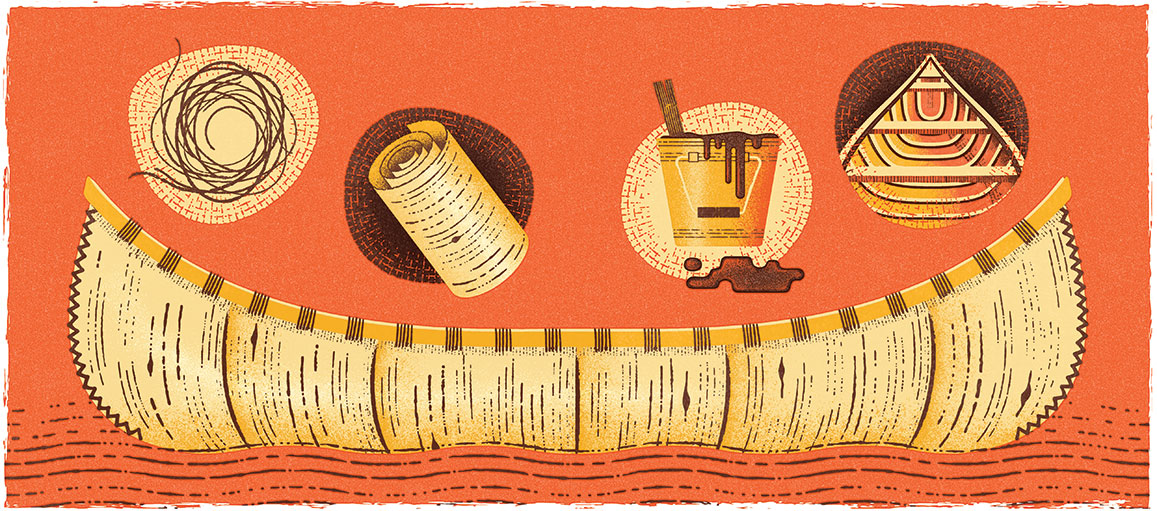
How to build a birchbark canoe
In the early 1700s, the forests of what will come to be known as Canada are vast and seemingly impenetrable, but you still need to move quickly as you carry hundreds of kilograms of goods and furs. For centuries, Indigenous peoples of the eastern woodlands have been building light and durable birchbark canoes that can help you navigate the water highways that lie ahead.
Begin collecting what you will need to build the canoe. This is the most difficult step, but the effort will pay off — if you find quality material, your canoe can last a century.
Harvest the bark around June, when the sap is flowing. Remove it carefully by peeling off only the outer layer, so the tree can still survive by growing new bark.
Construction will take about a week.
- Look for a large, straight tree free of limbs, bumps, and cracks. Test a small piece of bark to ensure that it is flexible and not brittle. Remove the bark in one large piece with your hands after cutting it with a sharp edge.
- Collect spruce roots in a swampy or sandy area where they grow in straight lines. Pull roots from ground, remove the bark, and split them in half.
- Collect spruce gum (sap) by scraping it off natural tree wounds. Heat in a pot over fire and add animal fat. In cool weather add more fat so the gum won’t crack. Add less in warm weather so the gum will stay hard.
- Build the canoe frame out of cedar. Place the frame on top of the bark. The bark’s white outer layer should face up so it becomes the inside of the canoe. Cover the frame with rocks to hold it in place.
- Bend the bark upwards and hold it in place with stakes driven into the ground. Make slits in the bark to allow for the curve. Sew sections of bark together with spruce roots.
- Build the upper edges of the canoe frame — the inner and outer gunwales — and sandwich the bark between them. Wrap spruce roots around the gunwales to hold everything together.
- Add the bow and stern. Take out the frame and add thwarts (lateral crosspieces). Add sheathing (thin pieces of cedar) and ribs.
- Apply the spruce gum mixture over the seams to seal and waterproof the canoe.
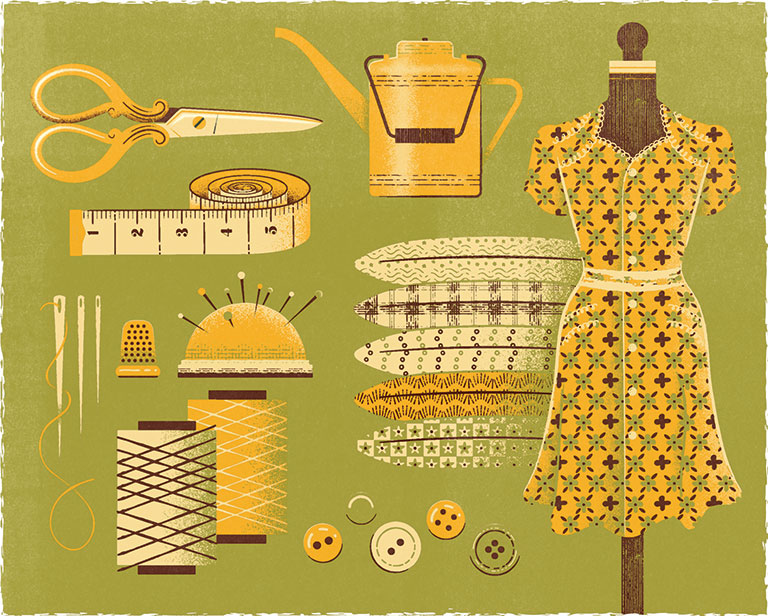
How to make a feed-sack dress
Are you a thrifty and creative housewife looking for new clothing and home textiles?
Why not make them yourself from empty flour or feed sacks!
In the tough economic times of the 1930s, when fabric is expensive and hard to come by, there is ample cotton available from bags containing flour, sugar, or animal feed. These sacks can be converted into many different items, from curtains and dish towels to clothing.
If you are lucky, you will find bags already printed with attractive patterns. But if the chicken feed comes only in plain beige bags, fear not — you can easily dye and decorate the cotton to your pleasing.
All you need for your dress are three bags and a pattern. You can even order the booklet Smart Sewing Suggestions from Maple Leaf Milling Co. for more inspiration.
- Most cotton bags are sewn with chain stitching that begins in the lower corner near the fold. Cut the chain close to the bag. Hold on to the ends of the upper and lower threads and pull them, ripping the stitching apart.
- Cover any markings on the bag with lard or soak them in kerosene overnight. The next day, wash the bag with lukewarm water. A few more washings will remove any remaining traces of ink.
- Dye the material, if desired. The material dyes easily and produces rich and long-lasting colour.
- Use your pattern to cut out and sew your dress. You may have to piece together sections of fabric to fit the pattern.
- Finish off any raw edges by applying bias tape. Embroider designs or appliqué patterned pieces of fabric onto the dress to decorate it.
Save as much as 40% off the cover price! 4 issues per year as low as $29.95. Available in print and digital. Tariff-exempt!
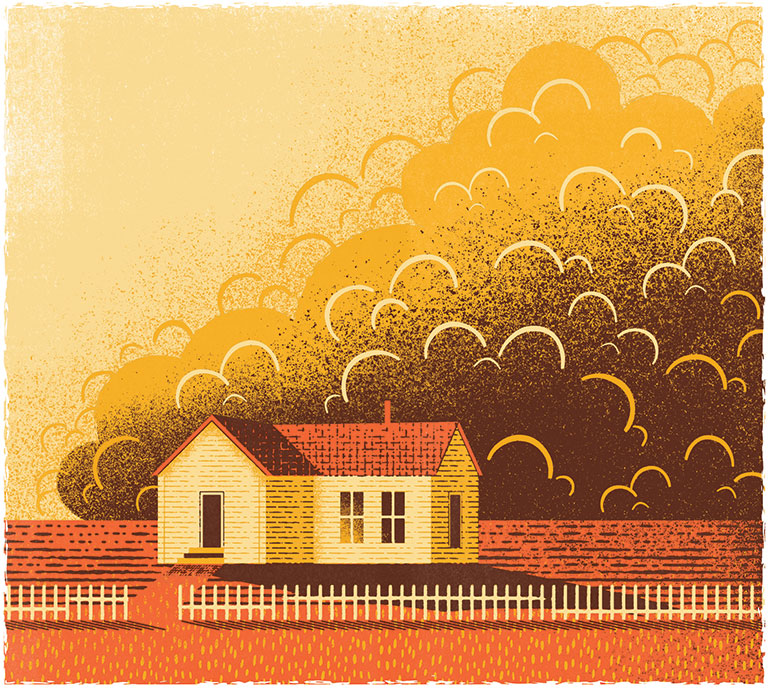
How to survive a dust storm
You see the cloud rising massively on the horizon, blackening the sky. You have only moments to spare before the dust storm reaches your home.
It’s the beginning of the dust bowl during the dirty thirties, a decade full of drought, scorching temperatures, crop disease, and insect plagues on the prairies. Though crop production is declining, farmers will continue to plant in hopes the worst has passed. The seemingly endless dry spell will eventually force thousands of climate refugees to flee the southern prairies.
The storm hits, and loose topsoil fiercely swirls about. You can barely see the ground at your feet, and you have difficulty breathing. Surviving these regularly occurring dust storms and adjusting to their presence has become a way of life.
- Take shelter.
- Put a lamp on the windowsill so your children will spot the house on their way home from school.
- Place wet rags or sheets at the bottom of doors and along windowsills.
- Set the table with dishes upside-down. Store dishes the same way.
- When outside, cover your face using homemade goggles, a damp kerchief on your nose and mouth, or a veil.
- When the storm passes, sweep away the piles of dust.
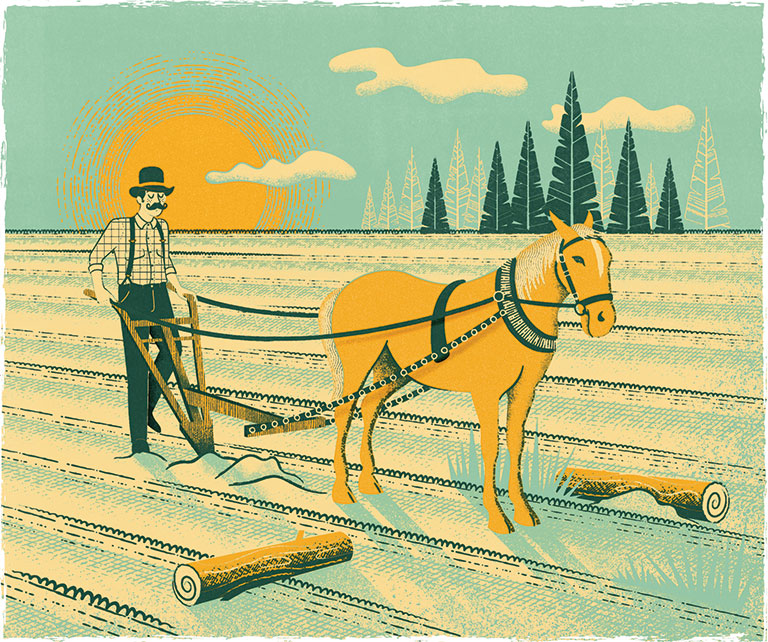
How to prepare your land for seeding
The journey from York to your new homestead in the London District of Upper Canada was arduous, but now that you’ve arrived you know that it was worth it. You immediately set to building a log house. Without shelter, you and your family won’t last long out here in the wilderness.
It’s back-breaking work building your home, but soon it’s finished — now it’s time to focus on your next task. You can already imagine the golden wheat and stooks of hay surrounding your newly built cabin — but that’s not what’s in front of you now at the beginning of the nineteenth century. Instead, your land is covered in rocks and trees.
You hope your property will eventually be bountiful enough to provide for your family, and even to yield extra crops that you can sell. You need to clear the land, a process that will span years; but even before it is completely clear you can sow crops between tree stumps.
- Cut down trees. Use a stoneboat (a wooden sled) or wagon to carry stones away. Break up large stones with a sledgehammer, or use a horse or ox and a chain to drag them out.
- Pull a plough through the land using oxen or horses. Do this about four years after beginning to clear the land so that any remaining stumps have rotted, making them easier to pull from the ground.
- Drag a harrow — a wooden frame that has spiked teeth or a tree limb — behind horses or oxen, working the land between remaining stumps.
- Break up the dirt with a roller, a round piece of wood pulled by horses or oxen.
- Pull out any remaining rotten stumps using a yoke of oxen.
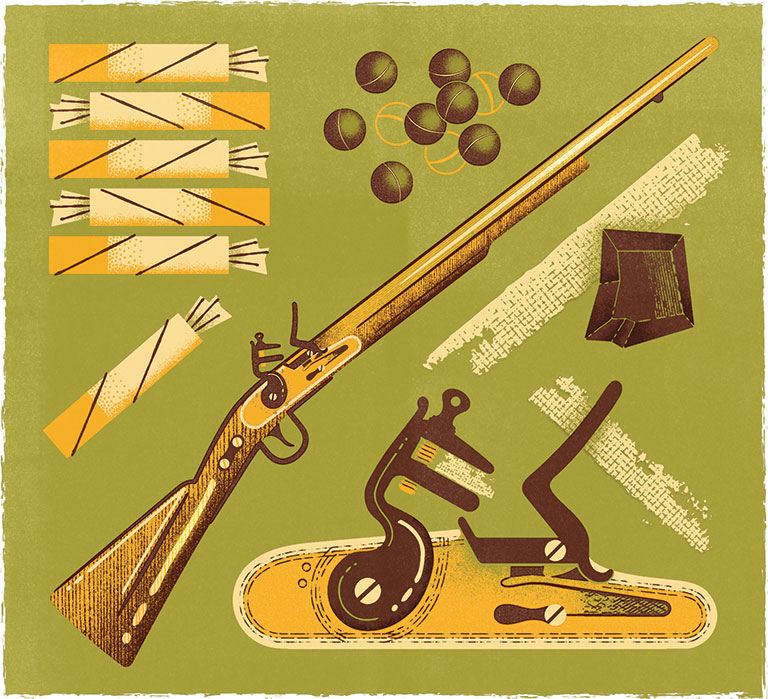
How to fire a musket
It’s September 1759, and you find yourself on the Plains of Abraham as part of a last-ditch British effort to capture the fortress of Quebec. In the distance, the French forces approach. The fate of the continent hangs in the balance.
Victory will go to the troops that can fire their muskets the fastest and, above all, can hold the line the longest. You and your fellow redcoats have spent untold hours drilling for this moment.
- Grab a black-powder cartridge and use your teeth to tear open its tail, the piece of paper at its end.
- Cock the musket halfway and push forward the hinged metal frizzen to reveal the flash pan. Pour in a small amount of black powder.
- Close the flash pan and hold the musket vertically with the barrel up.
- Empty the remaining black powder into the barrel.
- Insert a lead ball into the barrel and then push in the remaining cartridge paper.
- Use a ramrod to push the wadded cartridge paper and ball into the breech.
- Cock the musket fully.
- Aim and fire.
Editor’s Note: Enjoy “Old-School DIY” but remember that this is informational only, for your reading pleasure. Influenza, muskets, unknown plants — even igloos — can be hazardous to one’s health. These instructions are simplified and condensed.
The full feature appears in the February-March 2019 issue of Canada’s History. For more details about the steps outlined in “Old-School DIY,” visit the resources below.
How to make spruce beer
- Beattie, Owen. “Scurvy.” The Canadian Encyclopedia. Edited July 27, 2015.
- Durzan, Don J. Arginine, Scurvy and Cartier’s ‘Tree of Life’. Journal of Ethnobiology and Ethnomedicine. Published February 2, 2009.
- Kalm, Peter. Peter Kalm’s Description of Spruce Beer. Translated by Esther Louise Larsen. Agricultural History, 1948.
- Mitchell, Ross. “Early Northern Surgeons.” The Beaver, March 1954.
- Parks Canada. “Spruce Beer.” Government of Canada. Edited October 10, 2017.
How to cure cod
- Beatty, S.A. and H. Fougère. The Processing of Dried Salted Fish. Fisheries Research Board of Canada, 1957.
- Ferguson, Mark Eliot. “Making Fish: Salt-Cod Processing on the East Coast of Newfoundland — A Study in Historic Occupational Folklife.” Master’s thesis, Memorial University of Newfoundland, 1996.
- Higgins, Jenny. “19th Century Cod Fisheries.” Heritage Newfoundland and Labrador.
- Ryan, Frank. “New Life in an Old Land.” The Beaver, March 1942.
How to treat the flu
- AMEC Environment & Infrastructure. “Summary of Useful Plant Species Detected on the Project Sites.” A Mi’kmaq Traditional and Ecological Review of Three Wind Project Development Properties. Published December 2013.
- “Common Yarrow.” Alberta Plant Watch.
- Hallworth, Beryl. “Yarrow.” The Canadian Encyclopedia. Edited March 4, 2015.
- Yarnell, Eric, Kathy Abascal, Carol G. Hooper. “Herbs for Seasonal Influenza.” Clinical Botanical Medicine. Mary Ann Liebert, 2003.
- “Yarrow.” Encylopedia.com.
How to make pemmican
- Colpitts, George. Pemmican Empire: Food, Trade, and the Last Bison Hunts in the North American Plains, 1780-1882. Cambridge: Cambridge University Press, 2014.
- “Food.” Louis Riel Institute.
- Foster, John E. “Pemmican.” The Canadian Encyclopedia. Edited March 4, 2015.
- “Pemmican and How to Make it.” The Beaver, Summer 1964.
How to start a fire with a bow drill
- Primitive Skills. “Survival Fire Making - Friction Fire with Bow Drill.” YouTube video, 5:47.
How to build an igloo
- Gibson, William and John G. Cormack. “Building a Snow House.” The Beaver, March 1940.
- Strochlic, Nina. “How to Build an Igloo.” National Geographic. November 1, 2016.
- Smith, Craig S. “A Lost Art in the Arctic: Igloo Making.” The New York Times. June 21, 2017.
- Wilkinson, Douglas. How to Build an Igloo. National Film Board of Canada. 1949. 11 minutes.
How to build a birchbark canoe
- Kavanagh, Judy. “Building a Birchbark Canoe.” Edited 2001.
- Keighley, Sydney. “Trader, Tripper, Trapper.” The Beaver, December 1988-January 1989.
- Marsh, James H.“Birchbark Canoe.” The Canadian Encyclopedia. Edited March 4, 2015.
- Smith, Pinock.“Pinock: Independent Arts & Crafts Professional.”
How to make a feed-sack dress
- Connoly, Lois. “Recycling Feed Sacks and Flour Bags: Thrifty Housewives or Marketing Success Story?” Dress 19 (1992).
- Knapp, Jessica. “Flour Sack Dress.” Canada’s History, October-November 2015.
- Powell, Margaret. “From Feed Sack to Clothes Rack: The Use of Commodity Textile Bags in American Households from 1890 – 1960.” Textile Society of America Symposium Proceedings. Published 2012.
- Virtual Museum of Canada. “Flour Sack Costumes.” Narrative Threads: Crafting the Canadian Quilt.
- Virtual Museum of Canada. “Flour Sack Tea Towels.” Narrative Threads: Crafting the Canadian Quilt.
How to survive a dust storm
- Colpitts, George, Shannon Stunden Bower, and Bill Waiser. Climate and Change: Making Sense of the Dustbowl Years on the Canadian Prairies.
- Waiser, Bill. “Darkness at Noon.” Canada’s History, August-September 2018.
How to prepare land for seeding
- Ripley, P.O. and J.M. Armstrong. Land Clearing. Dominion of Canada — Department of Agriculture, 1946.
- Sloane, Eric. The Seasons of America Past. New York: Dover Publications, 2005.
How to fire a musket
- Dan Snow’s History Hit. “How to Fire a Brown Bess Musket - English Heritage.” YouTube video, 1:49.
- Piers, Charles. “Fire-Arms of the Hudson’s Bay Company.” The Beaver, March 1934.
We hope you’ll help us continue to share fascinating stories about Canada’s past by making a donation to Canada’s History Society today.
We highlight our nation’s diverse past by telling stories that illuminate the people, places, and events that unite us as Canadians, and by making those stories accessible to everyone through our free online content.
We are a registered charity that depends on contributions from readers like you to share inspiring and informative stories with students and citizens of all ages — award-winning stories written by Canada’s top historians, authors, journalists, and history enthusiasts.
Any amount helps, or better yet, start a monthly donation today. Your support makes all the difference. Thank you!
Themes associated with this article
Advertisement
You might also like...

Canada’s History Archive, featuring The Beaver, is now available for your browsing and searching pleasure!




